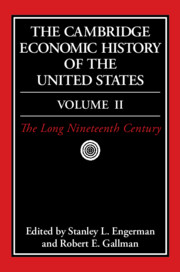Book contents
- Frontmatter
- 1 Economic Growth and Structural Change in the Long Nineteenth Century
- 2 The Economy of Canada in the Nineteenth Century
- 3 Inequality in the Nineteenth Century
- 4 The Population of the United States, 1790–1920
- 5 The Labor Force in the Nineteenth Century
- 6 The Farm, The Farmer, and The Market
- 7 Northern Agriculture and the Westward Movement
- 8 Slavery and its Consequences for the South in the Nineteenth Century
- 9 Technology and Industrialization, 1790–1914
- 10 Entrepreneurship, Business Organization, and Economic Concentration
- 11 Business Law and American Economic History
- 12 Experimental Federalism: the Economics of American Government, 1789–1914
- 13 Internal Transportation in the Nineteenth and Early Twentieth Centuries
- 14 Banking and Finance, 1789–1914
- 15 U.S. Foreign Trade and the Balance of Payments, 1800–1913
- 16 International Capital Movements, Domestic Capital Markets, and American Economic Growth, 1820–1914
- 17 The Social Implications of U.S. Economic Development
- Bibliographic Essays
- Index
- References
15 - U.S. Foreign Trade and the Balance of Payments, 1800–1913
Published online by Cambridge University Press: 28 March 2008
- Frontmatter
- 1 Economic Growth and Structural Change in the Long Nineteenth Century
- 2 The Economy of Canada in the Nineteenth Century
- 3 Inequality in the Nineteenth Century
- 4 The Population of the United States, 1790–1920
- 5 The Labor Force in the Nineteenth Century
- 6 The Farm, The Farmer, and The Market
- 7 Northern Agriculture and the Westward Movement
- 8 Slavery and its Consequences for the South in the Nineteenth Century
- 9 Technology and Industrialization, 1790–1914
- 10 Entrepreneurship, Business Organization, and Economic Concentration
- 11 Business Law and American Economic History
- 12 Experimental Federalism: the Economics of American Government, 1789–1914
- 13 Internal Transportation in the Nineteenth and Early Twentieth Centuries
- 14 Banking and Finance, 1789–1914
- 15 U.S. Foreign Trade and the Balance of Payments, 1800–1913
- 16 International Capital Movements, Domestic Capital Markets, and American Economic Growth, 1820–1914
- 17 The Social Implications of U.S. Economic Development
- Bibliographic Essays
- Index
- References
Summary
U.S. TRADE AROUND 1800
Trade was on the minds of the entrepreneurs who financed the first settlements in the Americas. They dreamed of riches – the kind that could come only from exploiting the natural resources of areas newly opened to European settlement and exporting the products. They did not envisage financing subsistence farmers or artisans or manufacturing settlements serving local markets.
As it turned out, the American colonies were, in their early days, heavily involved in exporting. They probably exported something like a quarter of their production in the early years of the eighteenth century (Gallman, and Lipsey, both in Davis, Easterlin, Parker, et al., 1972). By the end of the eighteenth century that export propensity had been cut in half. Thus, around 1800, something like 10 to 15 percent of U.S. output was exported (ibid., and Shepherd and Walton 1972, 44). To some extent, that decline in the export propensity could be attributed simply to population growth – larger countries tend to trade less in proportion to their output than smaller countries – but the decline in exporting was too large for much of it to be attributed to that cause.
- Type
- Chapter
- Information
- The Cambridge Economic History of the United States , pp. 685 - 732Publisher: Cambridge University PressPrint publication year: 2000
References
- 10
- Cited by



